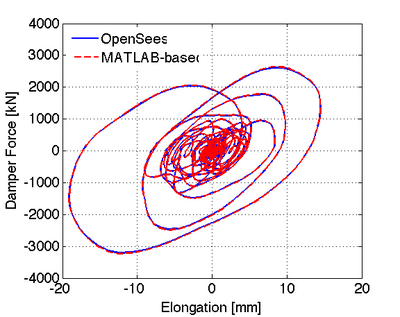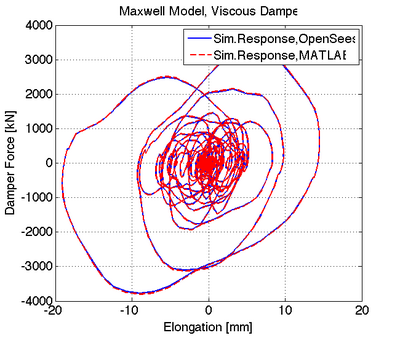Maxwell Material: Difference between revisions
Jump to navigation
Jump to search
No edit summary |
No edit summary |
||
| Line 43: | Line 43: | ||
|- | |- | ||
| [[File:Fig1.png|400px|thumb|left|Figure 1. Viscous Damper with K=150.0kN/mm, C = 100.0kN/(mm/s)^0.3, a=0.30]] | | [[File:Fig1.png|400px|thumb|left|Figure 1. Viscous Damper with K=150.0kN/mm, C = 100.0kN/(mm/s)^0.3, a=0.30]] | ||
| [[File:Fig2.png|400px|thumb| | }- | ||
| [[File:Fig2.png|400px|thumb|left|Figure 2. Viscous Damper with K=500.0kN/mm, C = 100.0kN/(mm/s)^0.3, a=0.30]] | |||
|- | |- | ||
|- | |- | ||
Revision as of 18:40, 15 February 2011
- Command_Manual
- Tcl Commands
- Modeling_Commands
- model
- uniaxialMaterial
- ndMaterial
- frictionModel
- section
- geometricTransf
- element
- node
- sp commands
- mp commands
- timeSeries
- pattern
- mass
- block commands
- region
- rayleigh
- Analysis Commands
- Output Commands
- Misc Commands
- DataBase Commands
This command is used to construct a Maxwell material (linear spring and nonlinear dashpot in series). The Maxwell material simulates the hysteretic response of viscous dampers.
| uniaxialMaterial Maxwell $matTag $K $C $a $L |
| $matTag | integer tag identifying material |
| $K | Elastic stiffness of linear spring (to model elastic stiffness of viscous damper) |
| $C | Viscous parameter of damper |
| $a | Viscous damper exponent |
| $L | Viscous damper length |
Examples:
References:
| [1] | Olsson, A.K., and Austrell, P-E., (2001), "A fitting procedure for viscoelastic-elastoplastic material models," Proceedings of the Second European Conference on Constitutive Models for Rubber, Germany, 2001. |
| [2] | Ottosen, N.S., and Ristinmaa, M., (1999). "The mechanics of constitutive modelling, (Numerical and thermodynamical topics)," Lund University,Division of Solid Mechanics, Sweden, 1999. |
Code Developed by : by Dr. Dimitrios G. Lignos (McGill University)

